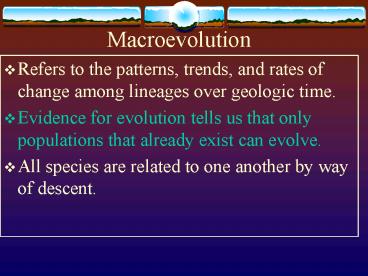Macroevolution - PowerPoint PPT Presentation
1 / 21
Title: Macroevolution
1
Macroevolution
- Refers to the patterns, trends, and rates of
change among lineages over geologic time. - Evidence for evolution tells us that only
populations that already exist can evolve. - All species are related to one another by way of
descent.
2
Evidence for Evolution
- Fossils (Paleontology)
- Comparative Morphology
- common ancestry
- vestigial organs
- Patterns of Development (Embryology)
- Comparative Biochemistry (Molecular Biology)
- Biogeography study of distribution of plants
and animals in the environment.
3
Fossils
- Recognizable, physical evidence of ancient life
- Fossilization is VERY slow
4
Types of Fossils
- Actual body parts left (hard body parts
shells, bones, teeth, woody stems). - minerals replace original remains
- (calcium replaced by limestone)
- remains trapped in resin amber
- remains trapped in ice or tar pits
5
Figure 25.1a Dinosaur National Monument
6
Figure 25.1c Petrified trees
7
Figure 25.1g Scorpion in amber
8
Figure 25.1h Mammoth tusks
9
- Imprint type of fossil formed when a film of
carbon remains after other elements of an
organism have decayed. - Mold fossil in which an impression of the
shape or track of an organism has been left. - Cast fossil in which sediment fills in the
cavity left by a fossil mold. (3-dimensional)
10
Figure 25.1d Leaf impression
11
Figure 25.1f Dinosaur tracks
12
Figure 25.0 Fossil of a fish perch
13
Dating Fossils
- ?Relative dating vs. Absolute age
- relative determined by looking at a fossils
position in sedimentary rock (if undisturbed
layers) and comparing with other fossils found - absolute determined by dating fossil with
radioactive isotopes (see page 420).
14
Evidence from Comparative Morphology
- Definition Comparative morphology field of
inquiry that looks at anatomical comparisons of
major lineages. (different body structures of
different groups) - WHEN INTRODUCING CHANGES IN BODYS DEVELOPMENT,
EVOLUTION TENDS TO FOLLOW LINE OF LEAST
RESISTANCE.
15
Morphological divergence vs. Morphological
convergence
- Divergence changes away from normal body
forms - homologous structures Ex. Vertebrate
forelimbs - Convergence dissimilar lineages (only remotely
related) evolve in similar directions (become
more similar) - analogous structures Ex. Flippers of
penguins, porpoises, and sharks
16
Figure 22.14 Homologous structures anatomical
signs of descent with modification
17
Common Ancestry and Vestigial Organs
- If organisms show speciation, then evolved from a
common ancestor - Ex. - Finches with different beaks on
Galapagos - Vestigial organs are functionless parts that an
organism has (and are often homologous to organs
that are useful in other species.) - Ex. - tailbone/appendix in humans
- -pelvic and limb bones in snakes
18
Evidence from Patterns of Development
- Developmental Program of Vertebrates
- -early embryos strongly resemble one another
because have inherited same ancient plan for
development
19
Evidence from Comparative Biochemistry
- Compare DNA, RNA, and proteins
- Protein comparisons hemoglobin comparison in
Biochemical evidence for evolution lab
20
Biogeography
- Distribution of organisms around the world
21
Distributionof Living Species
Section 15-3
Beaver
Beaver Muskrat Beaver andMuskrat Coypu
Capybara Coypu andCapybara
NORTH AMERICA
Muskrat
Capybara
SOUTH AMERICA
Coypu































